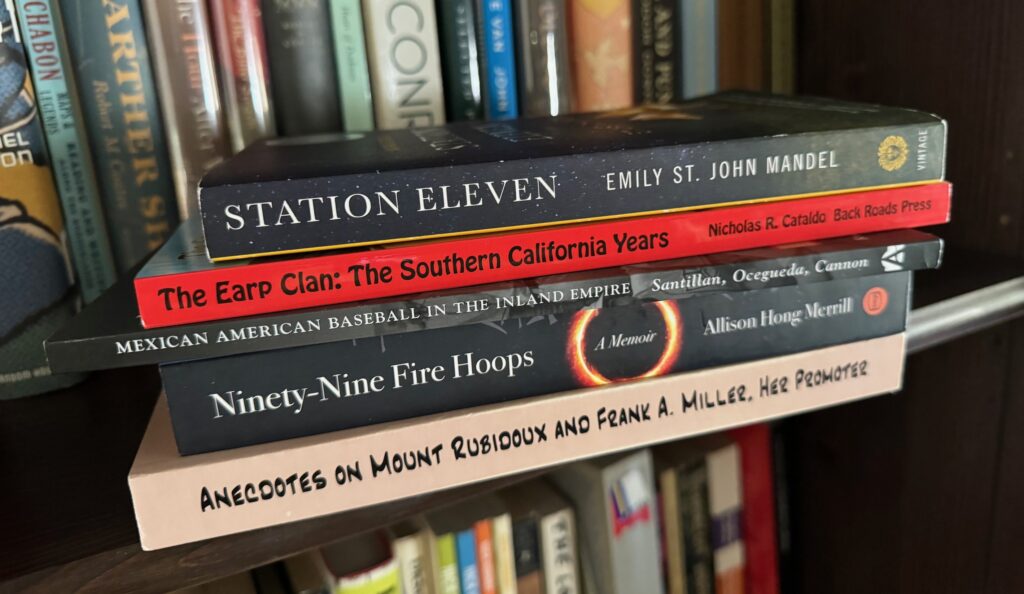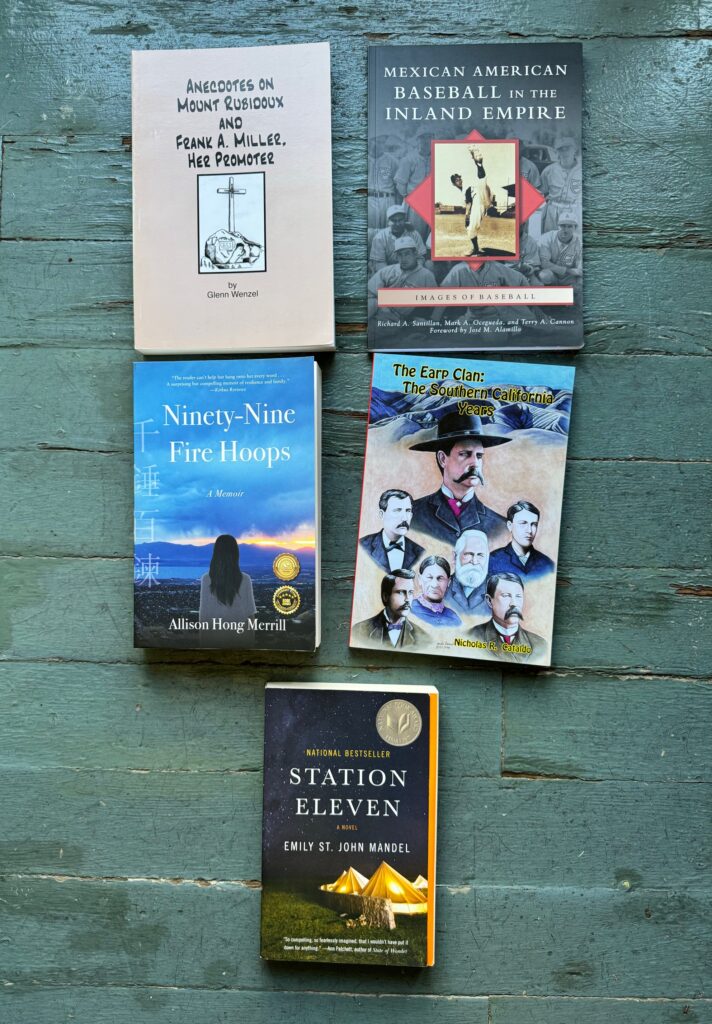People turned out to the library in droves for a recent talk about Zacatecas Cafe, an icon of Riverside’s eastside, in business for six decades. Also: a Riverside man’s 90th birthday was marked in a nationally syndicated jumble puzzle. And a notable Ontario native returns for an estate sale at his childhood home. Read all about it in my Sunday column.
Author Archives: David Allen
Column: Council meeting includes ‘Muppet Show’ guests
I attend a Riverside City Council meeting, during which outgoing council members popped off at the public, new members were sworn in (and immediately undid the previous council’s last action), and Councilmember Chuck Conder participated remotely while using a “Muppet Show” background. Also: an IE-wide history festival takes place Saturday in San Bernardino, I personally vouch for a problem detailed in our On the Road traffic column and Claremont shows up as a “Jeopardy” clue. All this is in my Friday column.
Column: HBO comic mocks Murrieta PD over Lego use
John Oliver wisecracks about Murrieta PD being chastised by Lego, which he calls a “pro-cop toy franchise.” Also: my day last Friday was hectic, but rewarding. And a famed LA pastor had Pomona Valley ties. All this is in my Wednesday column.
Column: 50 years ago, California Jam rock festival drew 200,000
It’s been 50 years since California Jam, a Woodstock-style rock festival, drew 200,000 to Ontario. I explain what it was all about and quote memories from fans in my Sunday column.
Column: Beware! Martian invaders are returning to Corona
1953’s “The War of the Worlds” contains two brief shots of downtown Corona. The movie screens Saturday in that city. Until recently, Corona’s inclusion in the film had been largely forgotten. Also: more about turning 60, including my first post-60 discount, all in my Friday column.
Column: Incumbents return without election fuss
I return to the La Verne Council Chambers for the first time in four years to watch two incumbents be sworn in for new terms. They got those terms without an election because no challengers filed to run against them. It wasn’t much in the way of news, but I seized it as an excuse to attend a meeting in good ol’ La Verne. Also: plugs for two events Thursday in San Bernardino and Riverside and a request for memories about the California Jam festival, which took place in Ontario 50 years ago this coming weekend. All this is in my Wednesday back-from-staycation column.
Reading Log: March 2024
Books acquired: “The Collapsing Frontier,” Jonathan Lethem; “Solito: A Memoir,” Javier Zamora; “Inland Empire and San Gabriel Valley Movie Theatres,” Kelli Shapiro; “The Freaks Came Out to Write,” Tricia Romano
Books read: “Station Eleven,” Emily St. John Mandel; “Anecdotes on Mount Rubidoux and Frank A. Miller, Her Promoter,” Glenn Wenzel; “Ninety-Nine Fire Hoops: A Memoir,” Allison Hong Merrill; “Mexican American Baseball in the Inland Empire,” Richard Santillan; “The Earp Clan: The Southern California Years,” Nick Cataldo
How can this be April? I started a list of goals for the year, never went back to finish it, and already the year is one-fourth done. That’s ridiculous. Maybe I should write off 2024 and start planning for 2025.
Well, here we are. Nothing to do but make the best of what’s left of the reading year. Which, to be fair, IS nine whole months. We can get a lot done in nine months! Even if we didn’t get a lot done in three months.
In March I read one acclaimed novel and four nonfiction books, three of the latter about the Inland Empire. And all were gifts — more on that later. Let’s get started.
“Station Eleven” (2014): Intricately constructed and gracefully written, this was a modest pleasure to read. Yet very little happens, and there must have been a reason, besides a busy schedule and deliberate reading pace, that I rarely surpassed 20 pages a day. I liked it without ever quite finding it compelling. Post-pandemic, this post-plague novel carries an extra punch, of course, as in this line: “…this illness Hua was describing was going to be the divide between a before and an after, a line drawn through his life.” Yep. (Birthday gift from a friend, 2023.)
“Ninety-Nine Fire Hoops” (2021): Starts off strong, with the author, an immigrant who speaks little English, arriving home to find that her husband and in-laws had moved all his stuff out without telling her. Whoa! But much of what follows has an oddly cheerful tone or a shallow point of view. Can I trust the writer’s version of events? And as there’s no attempt to connect her story to anything bigger, like the immigrant experience, why am I reading this? (Aside from the book being a gift, I mean.) When the man-of-her-dreams ending arrives, well, good for her, but it doesn’t make for satisfying reading. (Birthday gift from a friend, 2023.)
“Anecdotes on Mount Rubidoux” (2010): We have to cut local history some slack. The people compiling it for us are almost always history buffs willing to dedicate untold hundreds of hours to a topic, while not being professional writers. This book has a lot of facts and dates about Riverside’s signature natural feature, Mount Rubidoux, and its place in town as scene of what may be America’s first sunrise Easter service, among other things. It’s a tough read, but for my purposes, useful. (Gift of the author, 2022.)
“Mexican American Baseball in the Inland Empire” (2012): This is one of Arcadia Publishing’s Images of America photos-with-captions local histories, collecting private photos of teams and players from the ’30s to the ’60s, when Mexican American ball players had their own teams, leagues and stars. Rounding up the photos and information seen here, and in companion volumes about L.A., Orange County and other regions, was socially important. In book form it doesn’t make for very interesting reading, to be honest, and the snapshots are very similar and rudimentary. But the overall story of working-class people using sport as a release valve and social glue, forming community among themselves while being largely shut out of mainstream society, comes through. (Gift of a friend, 2023.)
“The Earp Clan” (2006): We all know of Wyatt Earp and his brothers’ exploits as lawmen in Tombstone, Arizona, probably through movies like “The Gunfight at the OK Corral,” “My Darling Clementine” or “Tombstone.” But that was only a couple of years of their lives. Most of them spent decades in San Bernardino County, around Redlands, Colton or San Bernardino. This book gathers up that information. With a chapter devoted to each family member, this gets rather repetitive; the wagon train that brought the Earps from Iowa is described a half-dozen times. Again, though, this was useful for me; I took notes and am thinking of how or when to write a capsule history in my column. (Gift of the author, 2023.)
Also during March, I got 40 pages into “Monogram,” a 1936 memoir by G.B. (Gladys Bronwyn) Stern before abandoning it. This was a 2021 Christmas gift from my brother, at my request. I’d seen a complimentary mention in a Robert Benchley essay (“Shattered Illusions”): “G.B. Stern, in her delightful book ‘Monogram’ (which, for my money, contains about everything that a book needs)…” Couldn’t help but be curious.
“Monogram” is not a traditional memoir and has almost no facts at all. Stern just lets her mind wander, changing subjects at will. She examines objects in her room, like a glass figurine, and sees where they take her, digression after digression. It’s a neat trick, but one I didn’t care to spend another week on. Here’s a piece about the book from The Neglected Books site, by someone who finds stuff to like, in “Monogram” and Stern’s seven other sort-of memoirs, and yet never finished any of them.
Now, about these books, and last month’s, as a whole.
After knocking out a half-dozen books in January. in February it seemed wise to concentrate on gift books, ones given to me by friends or occasionally by a writer friend or publisher. Sometimes the books are local in nature. Sometimes they are books in which I am quite interested, most obviously if I used a bookstore gift card to buy them (those are gifts of a sort); other times, I have no investment in the books at all, but a friend thought I would like them.
In February I read four such books and ended up acquiring one more. It seemed best to repeat the experiment in March, which is a good thing, because while I read five, and abandoned a sixth, another four came in. Birthday month, you know.
Out of 14 books finished so far in 2024, 10 were gifts. I still have, gulp, 23 gift books. I could spend the year reading nothing but those, and whatever fresh ones arrive. But that’s not really the direction in which I want to go. Instead, I’ll try to polish off one or two per month, on average, and maybe devote another month to ’em before year’s end. This may only keep me from falling further behind, but that’s something, right? Meanwhile, I’ll return my focus to my remaining pre-pandemic purchases.
OK, enough from me, and probably more than enough. What about you? What did you read, or abandon, in March? Sound off in the comments, please.
Next month: I hit my second Homer.
Column: Life in their 60s is ‘liberating’ and fulfilling, readers say
I asked for life advice about turning 60 and a bunch of you shared wisdom or perspective. Or jokes. I share some of that commentary, with some of my own, in my Wednesday column — before taking the rest of the week off.
Column: De Anza blazed trail through Riverside 250 years ago
Juan Bautista de Anza rode through Riverside and crossed the Santa Ana River on March 20-21, 1774, 250 years ago last week. He was the first non-native to document a visit to the future Inland Empire. I visit sites associated with him, including a statue in Newman Park, for my Sunday column. I’d heard of De Anza, and you probably have too, but I hadn’t understood who he was or his significance until now.
Column: Landmark Harris’ building donated to SB
Harris’ existence spanned the 20th century before its flagship San Bernardino department store closed in 1999. The massive building downtown has been vacant ever since. Now, its owner has finally relinquished the building, donating it to the city. I break that news in my Friday column.


